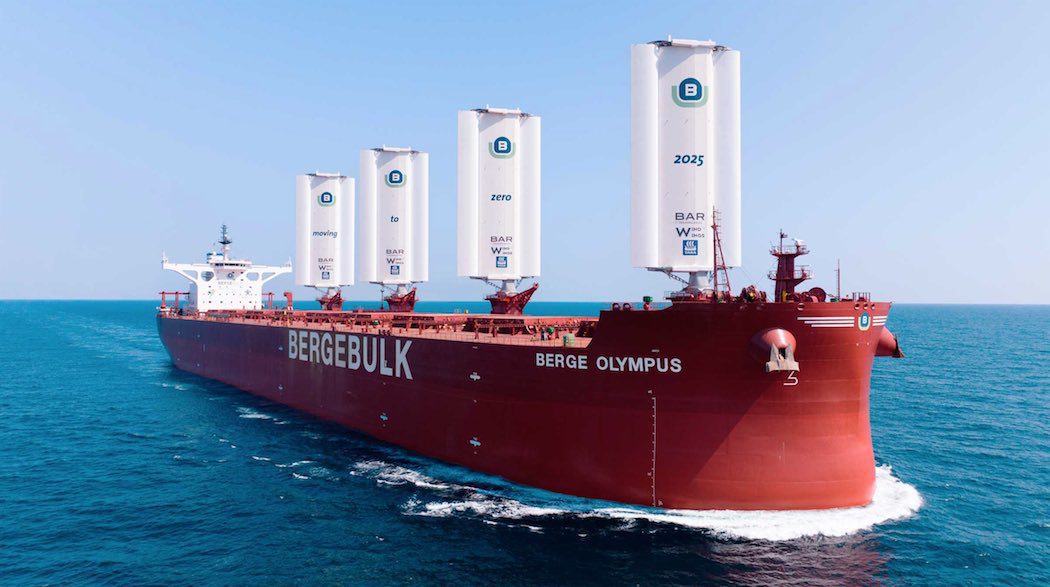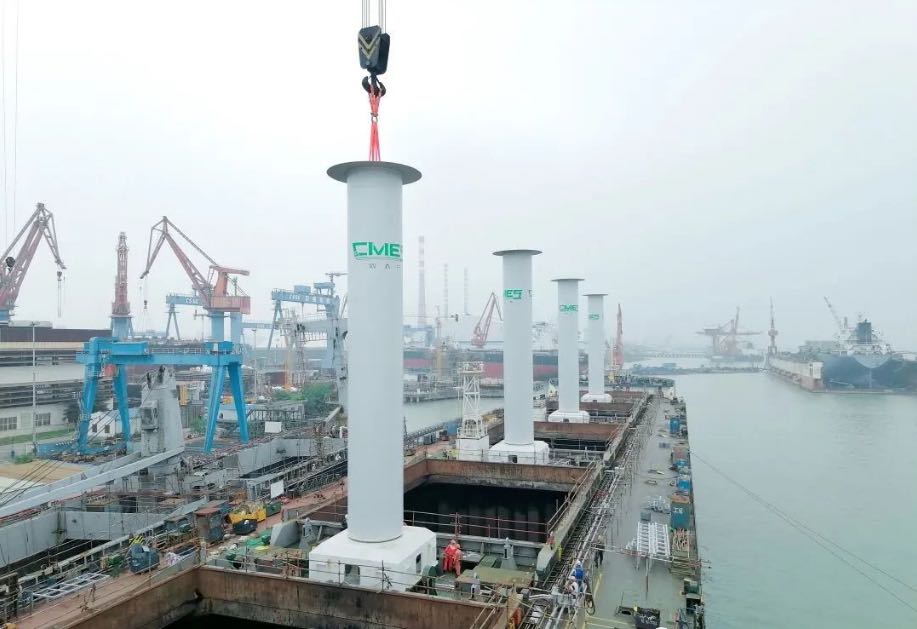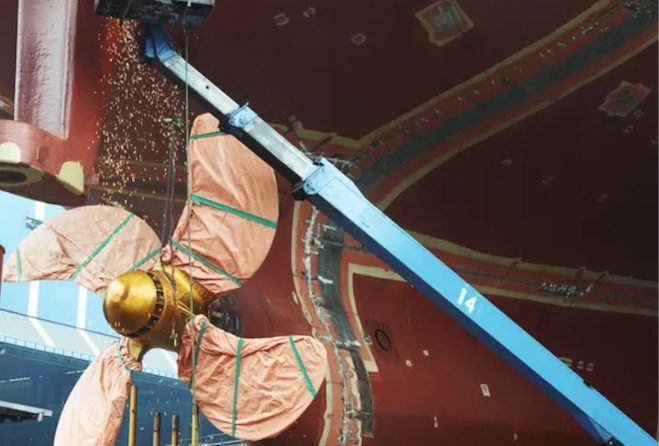28 November 2024
The World’s Most Powerful Windpower Cargo Ship

Berge Bulk, one of the world’s leading dry bulk ship owners, launches its windpowered Newcastlemax bulker, Berge Olympus, with four retrofitted BARTech WindWings by Yara Marine Technologies. The WindWings installation is part of Berge Bulk’s ambition to become carbon neutral by 2025 and marks the Berge Olympus as the world’s most powerful sailing cargo ship.
Table of Contents
Moving to Zero by 2025
Berge Bulk, one of the world’s leading dry bulk ship owners, launches its windpowered Newcastlemax bulker, Berge Olympus, with four retrofitted BARTech WindWings by Yara Marine Technologies. The WindWings installation is part of Berge Bulk’s ambition to become carbon neutral by 2025 and marks the Berge Olympus as the world’s most powerful sailing cargo ship.
Emission-Free Windpower
With four WindWings installed, each possessing an aerodynamic span of 37.5 meters height and 20 meters width, the windpowered Berge Olympus will save 6 tonnes of fuel per day on an average worldwide route and, in the process, reduce CO2 emissions by approximately 19.5 tonnes per day. With these fuel savings and CO2 reductions, Berge Bulk is evaluating the potential of windpower and installing Wings on more of its vessels that trade on routes with favorable wind conditions.

High-Tech Retrofit
Berge Bulk’s WindWings project is a testament to its commitment to leading the way toward a zero-carbon future while enhancing vessel efficiency. This initiative aligns with the new IMO goals, to reach net-zero GHG emissions from international shipping by or around, i.e. close to 2050, as well as indicative check-points for international shipping to reach net-zero GHG emissions for 2030 (by at least 20%, striving for 30%) and 2040 (by at least 70%, striving for 80%). Contributing to this mission, Berge Bulk’s Windpower project reflects its dedication to environmental sustainability and technological advancement.
In addition to the installation of the WindWings, Berge Olympus has been retrofitted with a shaft generator system. The shaft generator is driven by the main engine to supply electric power to the vessel, thus saving fuel and reducing emissions. With a 1MW capacity, it is sized to eliminate the need to operate auxiliary engines while at sea. This installation is in itself ground-breaking and concludes a program that saw multiple vessels retrofitted with the technology.

First Chinese Rotor Sails Retrofit gives up to 30% savings
A bulker fitted with CMES-Tech rotor sails took to the water at Chengxi Shipyard, marking a solid step forward for wind-assisted technology in China.
Ship Nerd
The Marshall Plan
As part of the global effort to reach future decarbonization goals, Berge Bulk is forging a trail to carbon neutrality by 2025 through safe, efficient, and sustainable shipping. To achieve this milestone, Berge Bulk has deployed a four-pillar decarbonization plan that focuses on improving fleet efficiency, leveraging the latest maritime technology, piloting new fuels, and investing in carbon capture, Berge Bulk calls it the Marshall Plan. Berge Bulk’s adoption of windpower — the culmination of years of research by naval architect BAR Technologies — highlights the clear opportunity for vessel owners to swiftly retrofit new technologies to make a rapid and profound difference to the climate impact of their fleet.
“At Berge Bulk, we are constantly striving to enhance our efficiency and reduce the environmental impact of our existing fleet. From 2008 until today, we have achieved a remarkable 46% reduction in our CO2 emissions per tonne mile, already surpassing the 2030 IMO target for reducing carbon emissions intensity. There’s still so much to do as we accelerate the transition to new fuel in the zero-carbon future. That is why we are proud to partner with BAR Technologies and Yara Marine Technologies to pioneer this WindWing system. The Berge Olympus is a testament to innovation and sustainability.”
James Marshall, Chief Executive Officer, Berge Bulk
“We’re immensely proud to be spearheading wind-assisted propulsion through the development of WindWings and through our shared vision with Berge Bulk to launch the world’s most powerful sailing cargo ship. We cannot afford to stand still in developing sustainable solutions for the shipping industry. We believe there is more to be done to harness wind power and push shipping into a greener, and more efficient era. To that end, we are already working on superior hydrodynamics and new types of accommodation blocks with several vessel designers.”
John Cooper, Chief Executive Officer, BAR Technologies
“Wind-assisted propulsion has the potential to offer immediate long-term solutions for shipping’s pathway to Net Zero. We are proud to work with trusted partners such as Berge Bulk and ensure that this technology can be scaled and manufactured to shipping’s high standards, ensuring a robust and resilient supply chain that can meet industry demand.”
Thomas Koniordos, Chief Executive Officer, Yara Marine Technologies
Key Facts
- Berge Olympus is a windpowered bulk carrier ship with four WindWings, a technology to reduce fuel consumption and emissions.
- Berge Olympus will sail between Brazil and China — a trade route known for having favorable windpower conditions.
- The WindWings are large, rigid sails that can be adjusted to optimize the aerodynamic performance of the ship.
- Each of the four Windpower Wings is 20m wide and 37.5m tall, which is taller than a 10-story building.
- The total surface area of the four wings is 3,000m2, which is more than three times the surface area of the wings of an A380 airplane (843m2).
- The WindWings can save up to 20% fuel, reducing CO2 emissions by 19.5 tonnes per day on an average worldwide route.
- The WindWing technology actively supports the industry in its mission to reduce the carbon intensity of international shipping by at least 20% by 2030 and 70% by 2040, reflected in the new IMO regulations.
- The WindWings are expected to achieve double-digit percentage reduction in fuel and CO2.
Source: Berge Bulk
See Also
According to the Program Manager of LR’s Maritime Decarbonisation Hub, Charles Haskell, the reality is that no ship can be fully future-proofed yet because the marine fuels of the future are still under development and there are few rules, designs, or builders, no crews, and no managers for the ships of tomorrow.

Retrofit vs newbuild? 45% of ships today will not comply
Carbon regulations targeting older, less efficient ships. Is it wiser to retrofit an existing vessel to improve its ratings, or replace it with a newbuild?


